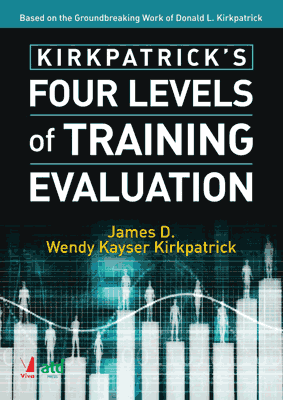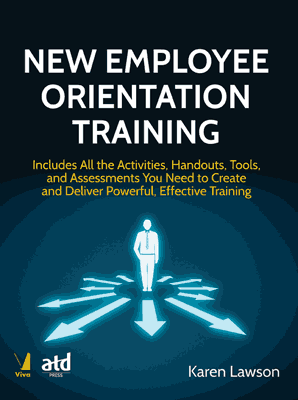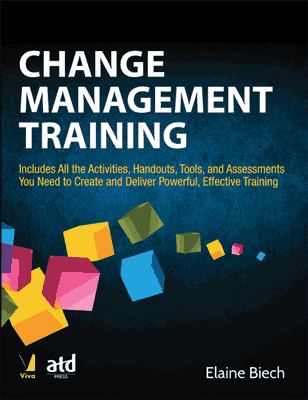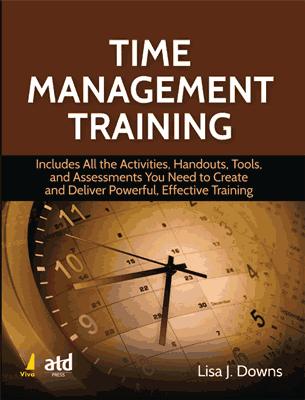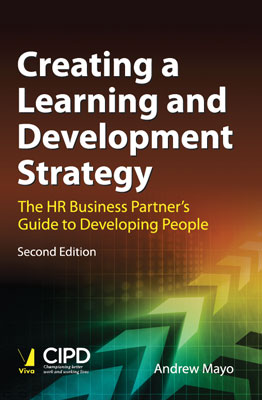Kirkpatrick's Four Levels of Training Evaluation
Kirkpatrick's Four Levels of Training Evaluation
₹1,075.50 ₹1,195.00 Save: ₹119.50 (10%)
Go to cart-
Out of Stock
ISBN: 9789387925489
Bind: Paperback
Year: 2020
Pages: 256
Size: 7 x 10 Inch
Publisher: ATD Press
Published in India by: Viva Books
Exclusive Distributors: Viva Books
Sales Territory: India, Nepal, Pakistan, Bangladesh, Sri Lanka
A timely update to a timeless model.
Don Kirkpatrick's groundbreaking Four Levels of Training Evaluation is the most widely used training evaluation model in the world. Ask any group of trainers whether they rely on the model's four levels Reaction, Learning, Behavior, and Results in their practice, and you?ll get an enthusiastic affirmation.
But how many variations of Kirkpatrick are in use today? And what number of misassumptions and faulty practices have crept in over 60 years? The reality is: Quite a few.
James and Wendy Kirkpatrick have written Four Levels of Training Evaluation to set the record straight. Delve into James and Wendy's new findings that, together with Don Kirkpatrick's work, create the New World Kirkpatrick Model, a powerful training evaluation methodology that melds people with metrics. In Four Levels of Training Evaluation, discover a comprehensive blueprint for implementing the model in a way that truly maximizes your business's results. Using these innovative concepts, principles, techniques, and case studies, you can better train people, improve the way you work, and, ultimately, help your organization meet its most crucial goals.
Target Audience:
Useful for HR and Trainers.
Contents:
Foreword by Don Kirkpatrick
Foreword by Elaine Biech
Preface
Part 1: Basics of Evaluation
Chapter 1: Reasons for Evaluating • The Urgent Need to Create and Demonstrate Training Value • Three Reasons to Evaluate Training Programs • Summary
Chapter 2: The New World Kirkpatrick Model—An Overview • The Four Levels • The New World Kirkpatrick Model • The Four Levels in Reverse • Summary • References
Chapter 3: Developing an Effective Evaluation Strategy • A Cautionary Tale • Not All Programs Are Created Equal • Three Phases of a Program • Training Is Like Flying a Plane • Summary
Chapter 4: The Kirkpatrick Foundational Principles • Kirkpatrick Foundational Principles • Summary
Part 2: Data Collection Guidelines, Methods, and Tools
Chapter 5: Evaluating Level 1: Reaction • Methods, Tools, and Techniques • Timing • Keep It Simple • Summary
Chapter 6: Evaluating Level 2: Learning • Methods, Tools, and Techniques • Timing • Summary
Chapter 7: Evaluating Level 3: Behavior • Research on the Importance of Post-Training Support • Defining the Few, Critical Behaviors • A Few Words About Competencies • Methods, Tools, and Techniques • Timing • Summary
Chapter 8: Evaluating Level 4: Results • Identifying Leading Indicators • The Benefits of Identifying Leading Indicators • Methods, Tools, and Techniques • Timing • Summary
Chapter 9: Evaluating Beyond Traditional Classroom Training • How to Evaluate E-Learning • How to Evaluate Informal Learning • How to Evaluate Mobile Learning • Summary
Chapter 10: Evaluation Instrument Creation Basics • Typical Questions • The Key to Success • Summary
Chapter 11: Blended Evaluation® Items and Sample Tools • The Blended Evaluation® Approach • Using Learner- Centered Items • Sample Methods and Tools • Item Library for Use Immediately Following Training • Item Library for Delayed Use After Training • Summary
Part 3: Data Analysis and Reporting Basics
Chapter 12: Making Data- • Based Decisions • Three Key Data Analysis Questions • Summary
Chapter 13: Using the Success Case Method to Drive Performance and Results • Defining Success • Training Evaluation Realities • Summary
Chapter 14: So What? Now What? • The Questions That Need to Be Answered • A Business Person's Criteria • PDCA Cycle • What Management Wants to Know • Outputs Versus Outcomes • Summary • References
Chapter 15: Reporting Progress and Demonstrating Program Value • Sharing Training Outcomes • Reporting Program Progress • Making an Impactful Final Report • Summary
Chapter 16: Avoiding Common Evaluation Pitfalls • Pitfall #1: Addressing Evaluation Requirements After a Program Has Launched ?
Pitfall #2: Viewing All Training Programs as Equal • Pitfall #3: Spending the Majority of Your Training Evaluation Resources on Levels 1 and 2 • Pitfall #4: Relying Solely on Standardized Surveys • Pitfall #5: Asking Questions That Don?t Generate Useful Data • Pitfall #6: Making Evaluation Too Complicated or Academic • Pitfall #7: Not Using Collected Data • Summary • References
Part 4: Case Studies
Chapter 17: Common Practice in Leadership Program: Greencore Northampton • Stakeholder Expectations • Program Structure • Evaluation Methods and Tools • Results of Pilot • Summary
Chapter 18: Service Over and Above the Rest (SOAR) Program: Emirates Airline • Actions • Pre-SOAR • Preparation • SOAR and Coach for Performance Formal Training • Formalized on-the-Job Support • The Evaluation and Reward Strategy • Results • Summary
Chapter 19: Sales Graduate Program Pilot: ArjoHuntleigh Getinge Group • Business Need and Program Intent • Stakeholder Expectations • Project Methodology • Evaluation Approach • Key Level 3 Findings • Key Level 4 Findings • Success Factors • Recommendations • Summary
Chapter 20: Accident Reduction Program: Maryland Transit Administration • Project Methodology • Required Drivers • Evaluation Methodology • Key Findings and Results • Program Success Factors • Barriers to Success • Summary
Chapter 21: Coaching Program: IHC New Zealand • Stakeholder Expectations • Critical Behaviors • Project Methodology • Evaluation Methods • Key Findings and Results • Success Factors • Barriers to Success • Recommendations • Summary
Call to Action • Your Personal Action Plan
References
About the Authors
About the Contributors
Index
About the Authors:
Dr. Jim Kirkpatrick and Wendy Kayser Kirkpatrick are co- owners of Kirkpatrick Partners. Together, they carry on the work of Jim's late father, Dr. Don Kirkpatrick, who served as the company's honorary chairman until his passing in May 2014.
Don created what later became known as the Kirkpatrick Model in the mid-1950s as part of his PhD dissertation. His goal was to effectively measure the impact of the management development programs he was teaching at the University of Wisconsin Management Institute. In 1959, Don first published his thoughts on training evaluation with a series of four articles in the Journal of the American Society of Training Directors entitled ?Reaction,? ?Learning,? ?Behavior,? and ?Results,? respectively.
After several years in the corporate world, Don returned to the University of Wisconsin, where he spent the remainder of his career as a professor. He published numerous books, served as the president of ASTD, and received various lifetime achievement awards, as well as a thought leadership award and induction into Training magazine's Hall of Fame.
Jim is a thought leader and change driver in training evaluation and the creator of the New World Kirkpatrick Model. Using his 15 years of experience in the corporate world, including eight years as a corporate training manager, Jim trains and consults for corporate, government, military, and humanitarian organizations around the world. He is passionate about assisting learning professionals in redefining themselves as strategic business partners to become a viable force in the workplace.
Jim delivers lively keynote addresses and conducts workshops on topics including using evaluation to help execute business strategy, building and leveraging business partnerships, increasing the transfer of learning to on- the- job behaviors, and maximizing business results.
Wendy is a global driving force of the use and implementation of the Kirkpatrick Model, leading companies to measurable success through training and evaluation.
Wendy's results orientation stems from more than two decades of business experience in retailing, marketing, and training. She has held positions as a buyer, product manager, process manager, and training manager, which leveraged her ability to organize complex, multifaceted projects and yield rapid results. As a training manager, she managed the training curriculum for 1,500 sales and customer service representatives across North America.
Wendy is a recipient of the 2013 Emerging Training Leaders Award from Training magazine.
Jim and Wendy have written three books, including Training on Trial: How Workplace Learning Must Reinvent Itself to Remain Relevant, and have also served as the subject matter experts for the United States Office of Personnel Management's Training Evaluation Field Guide: Demonstrating the Value of Training at Every Level.
When they are not working, Jim can be found on his boat fishing with his friends; Wendy alternately increases and decreases her carbon footprint with decorating projects in their home and conservation activities such as composting, recycling, and repurposing.
